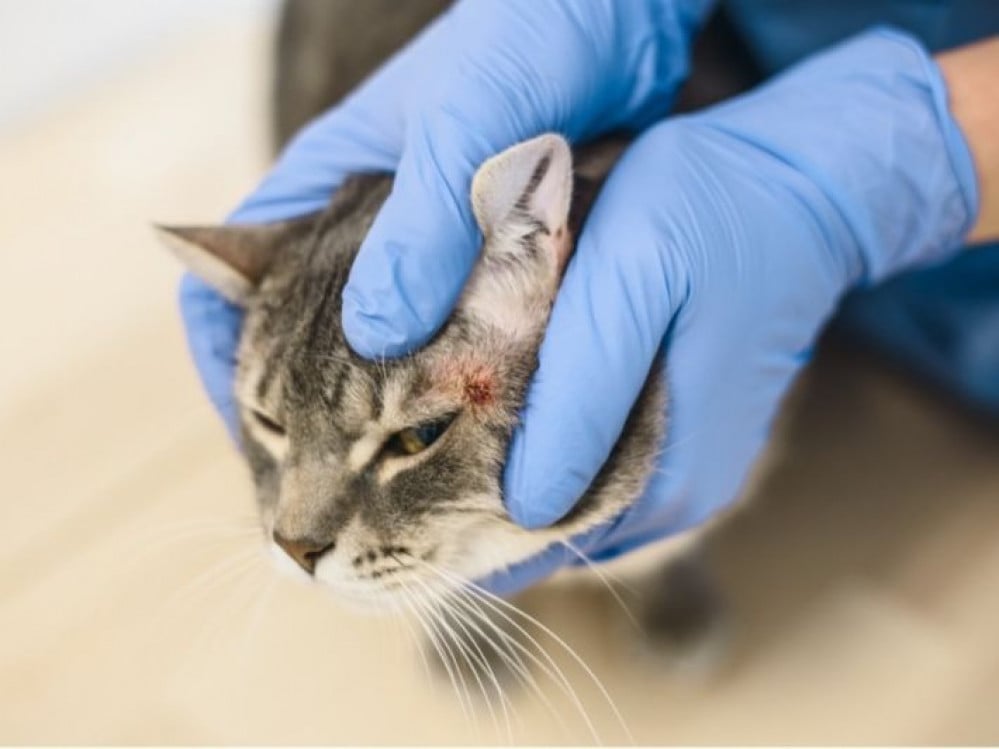Fungus is one of the most common cat diseases, as it is possible for a cat to become infected with it through inhalation, ingestion, or through the skin, which can transmit the infection to its breeder as well, and there are many types of fungi; Some of them cause infection, and some of them are not contagious, as most of them are found in the soil, which is the main carrier of it.
Types of cat fungi
There are several types of fungi that may infect cats, including:
Aspergillosis: Aspergillosis is a respiratory infection that affects almost all domestic and wild animals. Susceptibility to infection varies between species.
Symptoms: Signs of infection with this fungus appear in the form of sinusitis, facial swelling, and pneumonia.
Treatment: To treat this type of fungus, surgery or antibiotics are recommended.
Candidiasis: It is a rare disease in cats that affects the mucous membranes and skin.
Symptoms: Its signs appear in the form of skin lesions, general weakness, or in the form of diarrhea.
Treatment: Ointments may be useful in treating it or by injecting various drugs that are recommended by a veterinarian.
Coccidioidomycosis - Valley Fever (Coccidioidomycosis): Coccidioidomycosis is a non-infectious fungus that is concentrated in dry areas such as the desert and is transmitted through dust particles only. The cat gets it through inhalation, which is the only cause of infection.
Symptoms: Signs of infection appear in the form of weight loss, lack of appetite, and fever.
Treatment: The disease is treated with long-term antifungals, and reducing cat exposure to soil and dust.
Cryptococcosis: It is a fungal disease that affects the respiratory system, nervous system, eyes, and skin. It is transmitted mainly through soil and pigeon dung, and is one of the most common diseases among cats.
Symptoms: It appears in the form of sneezing, bloody secretions, lumps, or polyps, severe swelling under the skin and above the nose, seizures, depression, mood changes, slight paralysis, and may lead to blindness and the development of eye deformities.
Treatment: This disease is treated depending on the degree of its spread and the severity of the disease, which makes it require long-term treatment that may reach months, in addition to surgeries to remove lesions in the nasal cavity.
Histoplasmosis: It is a non-infectious fungus spread all over the world. It is spread by birds and bats. It primarily affects the lungs and lymph nodes in the chest when inhaled, and then spreads to all parts of the body and is concentrated in the bone marrow or eyes.
Symptoms: Signs of disease appear on the lungs and sometimes signs of fever, difficulty breathing, and persistent cough appear.
Treatment: Treatment can be difficult. The cat must be fed adequately, given adequate fluids, and continued treatment for long periods of time.
Causes of cat thrush
Due to the spread of fungi in various regions of the environment, it is possible for cats to pick up this infection, among the most common causes of fungal infection: [3]
Mixing with other infected animals.
Exposure to fungi in the soil.
The presence of wounds on the cat, which brings fungi.
Cats with immune diseases are more susceptible to infection.
Exposure to infected animal feces.
Symptoms of cat fungus in general
The symptoms of infection depend on the type of infection that was caught. Here are some of the most common symptoms among infected cats: [3]
Weight loss and anemia.
fever and seizures
Loss of appetite and depression.
Difficulty breathing, lung infections, and intolerance to physical activity.
Lesions on the skin.
Subcutaneous cysts.
Eye problems, sometimes causing blindness.
Bladder infections and diarrhea.
Bloody discharge in the nose and swelling under the bridge of the nose.
sneezing and coughing
Rotation.
paralysis.
Stages of cat fungus infection
Fungal infection in cats goes through many stages, namely:
Cats itch so badly that they mutilate themselves and itchy ears.
hair loss
The appearance of scales on the skin, and the amount varies from one cat to another.
The infection may sometimes cause blackheads to appear on the chin.
Infection may cause pigmentation and blackening of the skin in cats.
Redness of the areas where hair has been lost.
How to treat cat fungus
Treatment varies from one cat to another depending on the type of disease it has and its spread in the body, but as a group step you can do the following.
Cut hair and use topical treatments and antifungals.
Bathing with medicated cat shampoo and using oral medications.
Continuous follow-up until you notice any signs of improvement.
In the event that the fungus is secondary, you must take it to the doctor to give it medicines and intravenous fluids if necessary.

